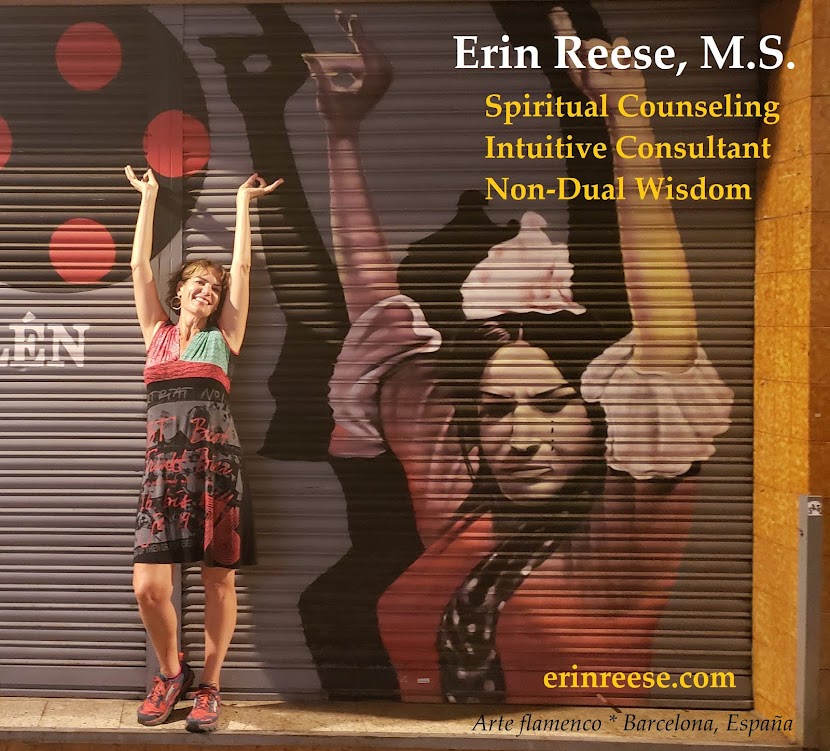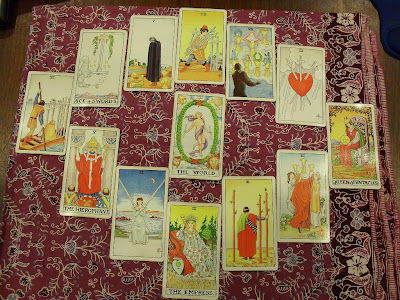This post is fourth in a five-part transpersonal theory series on spiritual unfolding and Vipassana meditation practice, originally presented in 2004 at the Institute of Transpersonal Psychology. Read Part One: Introduction and Part Two: Vipassana and Part Three: Spiritual Materialism and Transformation first, if you like. Enjoy! ~ ER

~ PART FOUR ~
Wilber’s Four Stages of Spiritual Unfolding
Discussion of the trappings of the spiritual ego lead us to now examine Vipassana meditation as it relates to Wilber’s four stages of spiritual unfolding – belief, faith, direct experience, and, finally, permanent adaptation. The first – and most common – stage, belief, is a stronghold of the ego. Beliefs originate at the mental level, and are “usually accompanied by strong emotional sentiments or feelings; but they are not necessarily direct experiences of supramental spiritual realities” (Wilber, 1999, p. 313).”
It is easy to believe in a spiritual precept or concept, but it doesn’t even come close to actually transforming. Beliefs “are merely forms of translation: they can be embraced without changing one’s present level of consciousness in the least” (Wilber, 1999, p. 313).” And then, something else begins stirring inside of us… Faith.
Faith, stage two of spiritual unfolding, is what blossoms when belief loses its power to compel. Beliefs eventually lose their forcefulness. As Wilber explains, “Mere belief may have provided you with a type of translative meaning, but not with an actual transformation, and this slowly, painfully, becomes obvious” (Wilber, 1999, p. 313-14). Because of the block of the ego, our intuition cannot be fully realized when our beliefs grip consciousness, for all beliefs are ultimately divisive and dualistic.
To me, faith is what develops when, through exposure to a practice or by encountering another transformative spiritual window of opportunity – which I call a moment of “grace”– we realize that our belief systems are outdated and we reach for something more. This “something more” pulls us toward itself like a magnet. In Buddhist terms, we decide to turn to a way out because “we see the reality of impermanence, egolessness, and suffering, we get fed up and disgusted with repeating the same pain over and over again. This is a very positive step… Therefore, we feel we must find a way out of our confusion” (Tendzin, 1982, p. 12). In essence this is where some sort of commitment to path comes into play. Taking refuge in the Triple Gem of Buddha, Dharma and Sangha can be considered a form of faith: “We acknowledge that the dharma is our basic guideline, our only reference point in working with everything we encounter in our life: our thought processes, emotions, bodily sensations, relationships, and so on” (Tendzin, 1982, p. 24).
 Even though the stage of faith is somewhat of a spiritual “halfway house” on the road to total spiritual transformation and becoming spirit, it is a critical developmental stage. In my own experience, I have relied on faith when I could not see a clear path in front of me. I have had to “act as if.” The faith stage is a bridge to true transformation, and must not be overlooked. Faith provides a natural progression, as innate as DNA in pulling a spiritual practitioner toward realization. Faith possesses a “dogged determination to find its spiritual abode," (Wilber, 1999, p. 314), and opens the door to the third stage of direct experience.
Even though the stage of faith is somewhat of a spiritual “halfway house” on the road to total spiritual transformation and becoming spirit, it is a critical developmental stage. In my own experience, I have relied on faith when I could not see a clear path in front of me. I have had to “act as if.” The faith stage is a bridge to true transformation, and must not be overlooked. Faith provides a natural progression, as innate as DNA in pulling a spiritual practitioner toward realization. Faith possesses a “dogged determination to find its spiritual abode," (Wilber, 1999, p. 314), and opens the door to the third stage of direct experience.
The third stage of spiritual unfolding, “direct experience of spirit,” can be divided into two territories: peak experiences and plateau experiences. Certainly, it is the allure of peak experiences that have drawn many sincere spiritual seekers, perhaps even myself, to become dedicated spiritual practitioners. Wilber cleverly points out the pun: “peak experiences,” which are usually brief, are frequently life-changing “peek experiences,” offering a glimpse “into the transpersonal, supramental levels of one’s own higher potentials” (Wilber, 1999, p. 314).” He asserts that, “Occasionally… individuals will have a strong peak experience of a genuinely transpersonal realm, and it completely shatters them, often for the better, sometimes for the worse. But you can tell they aren’t merely repeating a belief they read in a book, or giving merely translative chitchat: they have truly seen a higher realm, and they are never quite the same” (Wilber, 1999, p. 315). 
In my own meditation practice, I have had such “peek experiences” on an incredibly rare basis when “I” have left my body, looking down at myself, connected by an invisible thread to some grounded core. Such moments have been intense and awe-inspiring, encouraging me to continue on the slow, grueling practice days and months, which are the norm. It’s as if Spirit has given me a preview of some cosmic, far out bliss – just a nibble – and keeps the carrot dangling in front of me. Of course, as any basic Buddhist practitioner must learn, I have to immediately let go of expectations of reaching the impermanent, transpersonal state I have just been privy to, remembering the principle of “right effort,” which keeps me on the path, equanimous and unattached.
While peak experiences are enticing and often awe-inspiring, the REAL work in the third stage of spiritual unfolding begins with “plateau experiences.” Plateau experiences are more constant and enduring than peak experiences, “verging on becoming a permanent adaptation” (Wilber, 1999, p. 315). The bottom line is that to sustain a peak, or “peek” experience into a more enduring trait, prolonged practice is required. It’s as if we come to understand that “faith without works is dead” (James 2:14-26). In other words, we realize that in order to make any further progress, we have got to get serious about this business of practice. To me, this is clearly what separates the women from the girls and the men from the boys when it comes to walking – and living – on a genuine spiritual path.
I would be dishonest if I portended to be even one millimeter along this path, as spotty as my own meditation has been over the past three years. Perhaps, however, the clincher is: I have begun, and, as Lao Tzu taught, “The journey of a thousand miles begins with a single step.” Wilber also holds that the most important thing is to simply begin practice, to the best of our abilities.
Moving into the fourth stage of spiritual unfolding, we enter the realm of becoming spirit, or permanent adaptation. Adaptation is a “constant, permanent access to a given level of consciousness” (Wilber, 1999, p. 317). How do we get to these higher, transpersonal realms on a permanent basis? The answer, just like all extraordinary feats, is practice. It’s like the story of the man who pulled his taxicab over in New York City to stop a man for directions to Carnegie Hall. He noticed the man was carrying a violin case, so thought for sure he would know the answer. “Excuse me, sir, how do you get to Carnegie Hall?” The musician looked up at him from his brisk walk and replied, “Practice, practice, practice!”

Whether we’re discussing performing at the grandest symphony or reaching permanent adaptation of spiritual states, the answer is practice. Once we’ve accepted and embraced this fact, our practice can provide us with the skills that truly carry over into the rest of our lives. Our whole “experiential existence,” or state of being, becomes the game in which those basic skills are to be applied (Gunaratana, 1982).
In my efforts to notice how Vipassana practice seeps its way into my daily life, I have caught myself having a “permanent adaptation” state from time to time. For example, I have been acutely aware of meditating while in a lucid dreaming state – not entirely sure whether I was awake and meditating, or if I was dreaming that I was meditating. (Regardless, it was a real validation that my practice was deepening tremendously.) In fact, Wilber asserts that we have reached the stage of adaptation when we have such constant consciousness through all three states of waking, dreaming, and sleeping. You know you have become spirit “when you rest as pure, empty, formless Consciousness and ‘watch’ all three states arise, abide and pass, while you remain Unmoved, Unchanged, Unborn, and released into the pure Emptiness that is all Form, the One Taste that is the radiant All” (Wilber, 1999, p. 319).
Perhaps a simpler, more mundane example of “becoming spirit” as a permanent adaptation is when I am driving down the road, stuck in a horrific traffic jam, and suddenly become aware that I’m observing my breath and feeling the sensation it leaves as it moves in and out of my nostrils. I’ve been meditating unconsciously – or ultraconsciously as it were – being as non-reactive to the potentially stressful state of affairs as possible, and I wasn’t even on the meditation cushion. It was a rare moment of “spiritual soaring,” or becoming spirit. Huston Smith points out that right mindfulness “summons the seeker to steady awareness of every action that is taken.” A basic tenet of Vipassana, or insight meditation, that carries over into a more permanent adaptation, as I’ve described it here, is thus: “We should witness all things non-reactively,” and “keep the mind in control of the senses and impulses, rather than being driven by them” (Smith, 1991, p. 110).
On a subtler level, I have noticed how this fourth stage of spiritual unfolding, that of permanent adaptation or “becoming spirit,” penetrates my life and my relationships. As Tendzin (1982) reminds us, we cannot exclude the non-spiritual from our life, and nonduality includes the “postmeditation” day-to-day living. For me, this primarily means “sitting” with decisions, with emotions, with reactions to people, places, and things – observing and being aware, until some form of (usually) spontaneous insight arises through the practice of Vipassana. “Becoming spirit” and pure Consciousness also corresponds to the state of pure freedom, of liberation, that is a true aim of Buddhist practice. Huston Smith (1991, p. 119), in his usual ingenious manner, wraps it up simply: “If increased freedom brings increased being, total freedom should be being itself.”
(CONTINUED.)
Works cited in this series of posts:
Dhammadaro, A. L. (1998). Inner strength: sixteen talks Translated from the Thai by Thanissaro Bhikkhu. Valley Center, CA: Metta Forest Monastary.
Smith, H. (1991). The world’s religions: completely revised and updated edition of The religions of man. San Francisco: Harper.
Tendzin, O. (1982). Buddha in the palm of your hand. Boulder, CO: Shambala Publications, Inc.
Trungpa, C. (1973). Cutting through spiritual materialism. Berkeley, CA: Shambala.
Wilber, K. (1997). A spirituality that transforms. What is Enlightenment magazine, 12.
Wilber, K. (1999). One taste: the personal journals of Ken Wilber. Boston, MA. Shambala.
 This post is the final in a five-part transpersonal theory series on "Becoming Spirit" via spiritual unfolding and Vipassana meditation practice, originally presented in 2004 at the Institute of Transpersonal Psychology. ~ ER
This post is the final in a five-part transpersonal theory series on "Becoming Spirit" via spiritual unfolding and Vipassana meditation practice, originally presented in 2004 at the Institute of Transpersonal Psychology. ~ ER
























